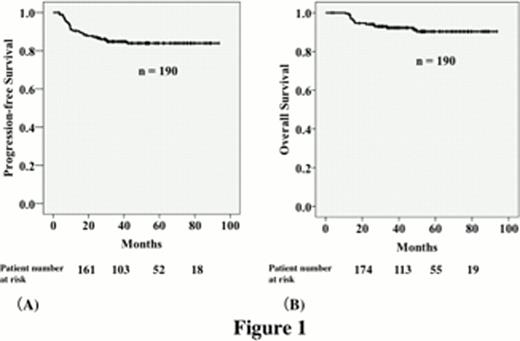Abstract
Abstract 1620
Few randomized prospective studies have been conducted on patients with localized DLBCL in the rituximab era. The SWOG 0014 study examined DLBCL patients treated with 3 cycles of R-CHOP followed by involved-field radiotherapy. Each of the patients had at least 1 of the 4 risk factors (nonbulky stage II, over 60 years of age, WHO performance status [PS] of 2, or elevated LDH), but showed 4-year progression-free survival (PFS) and 4-year overall survival (OS) rates of 88% and 92%, respectively. However, long-term observations showed that the PFS and OS curves did not plateau (Persky DO, et al. J Clin Oncol 2008). We retrospectively analyzed a series of patients with localized DLBCL treated with R-CHOP therapy alone.
This study included 190 consecutive, untreated patients with localized DLBCL seen between 2003 and 2009 in 1 of the 7 participating hospitals. All the patients were scheduled to undergo primary therapy with 6 cycles of full-dose R-CHOP in 1 of the hospitals. Patients who required a dose reduction of more than 20% were excluded from the study, as were patients with special forms of DLBCL, such as intravascular lymphoma, primary mediastinal large B-cell lymphoma, and T-cell-rich B-cell lymphoma. Patients who achieved partial remission (PR) after the 4 initial cycles underwent a total of 8 R-CHOP cycles. Patients who did not achieve PR after the 4 initial cycles or those with disease progression at any time during the study underwent salvage therapy, and that time point was designated as the point at which the disease progression began. Additional local irradiation was allowed in patients with PR. Patients who received additional radiotherapy following CR in the decision of attending physicians were excluded from this study. Patients who achieved CR but who were initially at risk of central nervous system (CNS) involvement received 4 intrathecal doses of methotrexate (15 mg) and hydrocortisone (25 mg) for CNS prophylaxis. Central pathological reviews were not performed; only the individual institutional diagnoses were used.
The study included 111 men and 79 women, with a median age at diagnosis of 63 years (range, 18–80 years). According to the IPI, 133 patients were classified as L; 49, as LI; 5, as HI; and 3, as H. Five patients received additional local irradiation after PR at the end of the R-CHOP therapy. CNS prophylaxis was performed in 15 patients who had an initial CNS risk and achieved CR. The median observation period for the living patients was 52 months. The responses to therapy were 180 CR, 8 PR, and 2 progression of disease (PD). The 5-year PFS and 5-year OS rates were 84% and 90%, respectively, and both plateaued (Figure 1). None of the patients experienced PD after 4 years of observation. Multivariate analysis revealed that the presence of bulky mass, which was evident in 18 patients, was an independent risk factor for PFS (P = 0.007, relative risk [RR] 3.5) and OS (P = 0.003, RR 5.8), along with poor performance status. During the observation period, 29 patients experienced PD. The progression sites included the primary sites in 15 patients, outside the primary sites in 10, and undetermined in 4. There were 16 deaths, 14 of which were due to the lymphoma. In 149 patients with at least one of the 4 risk factors used in the SWOG 0014 study, the 5-year PFS and 5-year OS rates were 86% and 94%, respectively.
Six cycles of R-CHOP therapy alone were observed to be highly effective in attaining good survival results with plateaus. These results suggest that the “standard” strategy of 3 cycles of R-CHOP followed by involved-field radiotherapy for localized DLBCL should be replaced by R-CHOP alone.
No relevant conflicts of interest to declare.
Author notes
Asterisk with author names denotes non-ASH members.


This feature is available to Subscribers Only
Sign In or Create an Account Close Modal